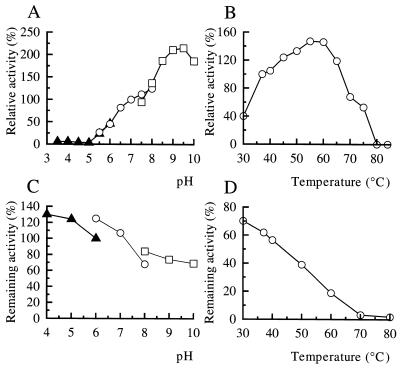FIG. 7.
Effects of pH and temperature on the PLA-degrading activity of the purified PLA depolymerase. (A and B) Optimal pH and optimal temperature. PLA-degrading activity of the purified enzyme was assayed under standard conditions, except for pH (A) and temperature (B), as described in Materials and Methods. (C) Stability of the PLA depolymerase at different pHs. The purified enzyme preparation was kept at different pHs at 4°C for 24 h, and residual PLA-degrading activity was assayed under standard conditions. (D) Stability of the PLA-degrading activity. The purified enzyme was kept at different temperatures for 1 h, and residual activity was assayed under standard conditions. The PLA-degrading activity obtained under the standard conditions was defined as 100%. Buffers used in the assays for optimum pH (A) and pH stability (C) of the enzyme activity were 10 mM sodium acetate buffer (▴) for pH 3.5 to 6.0 (A) and for pH 4.0 to 6.0 (C), 10 mM potassium phosphate buffer (○) for pH 5.5 to 8.0 (A) and for pH 6.0 to 8.0 (C), and 10 mM Tris HCl buffer (□) for pH 7.5 to 10.0 (A) and for pH 8.0 to 10.0 (C).

